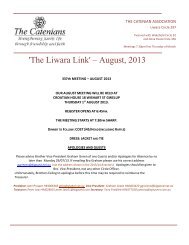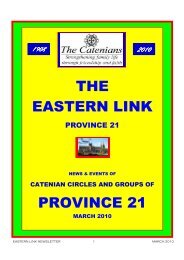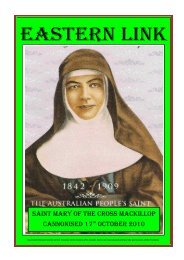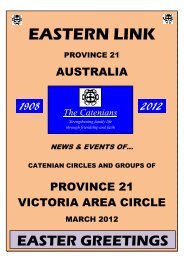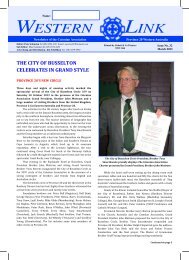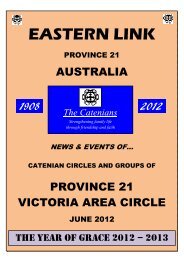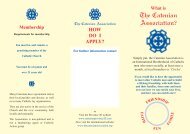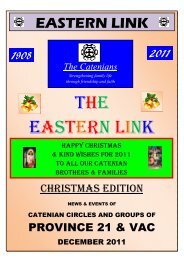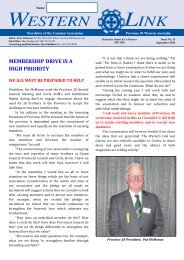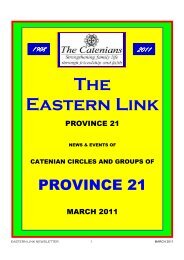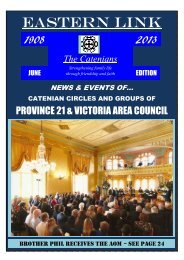Western Link - Vol 2 No 5 October 2009 - Province 20 Catenians of ...
Western Link - Vol 2 No 5 October 2009 - Province 20 Catenians of ...
Western Link - Vol 2 No 5 October 2009 - Province 20 Catenians of ...
Create successful ePaper yourself
Turn your PDF publications into a flip-book with our unique Google optimized e-Paper software.
GRAND PRESIDENT JOE Mc NALLY’S CONFERENCE ADDRESSHarrogate Conference <strong><strong>20</strong>09</strong> (slightly abridged)After thanking past G. C members and welcoming the new, he wenton as follows:-In his inaugural address the Grand President is asked to look beyondcontemporary horizons and <strong>of</strong>fer some vision <strong>of</strong> the future. The foundermembers <strong>of</strong> the Association, or its members in the aftermath <strong>of</strong> the WorldWars, would have found it difficult to predict that today we are a thrivingBrotherhood with a membership which transcends the globe as well asboth class and race. Our Association has much to be proud <strong>of</strong>.The international expansion <strong>of</strong> the Association has undoubtedly beenaided by substantial changes in travel and communications but thereis no escaping the fact that the enlarged geographical footprint <strong>of</strong> theAssociation has stretched its administration.It appears that the favourable economic conditions which haverevolutionised international travel and communications will not prevailin the foreseeable future. In the light, therefore, <strong>of</strong> current financialdifficulties and the ‘green’ imperative, we should not perhaps plan for thefuture based on the status quo but instead look for change. It is the same forthe structure <strong>of</strong> the Association: as we grow and develop we must ensurethat our governance and administrative structures can embrace changerather than be overwhelmed by it.I stress that I am concerned with the administration and governance <strong>of</strong> theAssociation, not its ethos. In that regard the foundation <strong>of</strong> the Associationupon Circles <strong>of</strong> Brothers cannot be improved upon; it is a foundationwhich we must be anxious to maintain. We must be resolute in improvingour administrative structure whilst simultaneously being determined not tolose the essence <strong>of</strong> our Brotherhood and that which sustains it.This is undoubtedly a challenge but in responding to it we must notbecome overawed by the apparent complexity <strong>of</strong> the problems we face. Itis true that many <strong>of</strong> the technological facets <strong>of</strong> our life have changed overthe years. However, it appears to me that many <strong>of</strong> the ‘core’ difficultieswe face remain in essence the same as those faced over 100 years ago bythe Chums. Then the founding <strong>of</strong> our Association was part <strong>of</strong> a Catholicresponse within society. It remains so now.In the introduction to his centenary history <strong>of</strong> the Association, BrotherJames Hagerty describes the foundation <strong>of</strong> the Association as growingout <strong>of</strong>: “the lingering anti-Catholic bigotry within contemporary BritishSociety which discriminated against them and prevented them fromjoining organizations open to men <strong>of</strong> similar economic interests andsocial status”... The Association was therefore born into an environmentwhere, despite the Catholic Relief Act <strong>of</strong> 1829, the majority <strong>of</strong> those whowere members <strong>of</strong> the Roman Catholic Church were still less than equalwithin society - nor were they trusted within it. With the exception <strong>of</strong> afew noble Catholic families who were within the ‘establishment’, evenin 1908 Roman Catholics generally remained at a disadvantage whenseeking to serve in positions <strong>of</strong> civil authority or high <strong>of</strong>fice, and some <strong>of</strong>these restrictions remain to this day. The hostility <strong>of</strong> English society to theChurch was apt to exclude Catholics from full participation.The Association, as a partial response to this, was based on simple preceptswhich have stood the test <strong>of</strong> time. Although its core values were not settledin a day, it became clear that the Association had two important principlesbehind it:First, the foundation <strong>of</strong> the Association upon Circles <strong>of</strong> men in bond as‘Brothers’ subject to their civil and moral obligations which should notbe subverted by their membership <strong>of</strong> the Association or their pledge toit; andSecondly, that the Association was an independent Association <strong>of</strong> Catholiclaymen. They were pr<strong>of</strong>essional and were free to have their own interests(including other Catholic activities) but these were outside <strong>of</strong> the nonpoliticalAssociation.It followed that by adherence to these principles those who joined theAssociation would not be prevented from serving in civic <strong>of</strong>fice ormoving within the establishment. <strong>No</strong> Catenian could be stigmatised by thesuggestion that their promise as a Catenian Brother would compromisethem in the discharge <strong>of</strong> any <strong>of</strong>fice. The Brotherhood <strong>of</strong> the Associationwas none the less vital for that. In my view, it is not without significancethat this approach promotes strength through unity, rather than division;after all a Circle <strong>of</strong> equals is created to promote Brotherhood, notdivision.These ideals found firm expression in our ethos and Rules. They explainwhy we have not sought or maintained any institutionalised political orcharitable objectives as an Association. Seen in its proper context, thisis not weakness but strength. Why? For the individual, it ensures thatno Brother joining the Association is beholden to any other because noBrother can pledge his position. Where a Brother seeks to support a worthycause, he does so personally - his Brothers may support him if they wishbut are not obliged to do so simply because <strong>of</strong> our Brotherhood.There is a wider significance to this. The simplicity <strong>of</strong> the Association’smodel ensures that it is not in competition ideologically or territorially withany other organisations. We can complement all and detract from none.Undertaking political argument is the function <strong>of</strong> political activism. Thiswas deliberately kept out <strong>of</strong> the Association and left to organisationscommitted to that type <strong>of</strong> enterprise. Our Association remains diverse andrelevant without the need to re-invent itself. We should jealously guardthis position. We know that for some this is not enough. We are all awarethat there are Brothers who say we should become a Catholic Action Groupand as an Association we should become collectively politically involved.This argument generally proceeds on the premise that the prospect <strong>of</strong>an increasingly secular society means that we can no longer afford theluxury <strong>of</strong> being a non-political Association. It implies that changingcircumstances in turn require the Association to change. I am not confidentthat this is so.It may be useful to first <strong>of</strong> all reflect that at the time <strong>of</strong> our formationin 1908, secularism was a major concern to the Church and indeed hadbeen for some considerable time. Within ‘Catholic Europe’ as opposed to‘Protestant England’, the French had, about 1<strong>20</strong> years earlier establisheda secular state. This meant that through the years which followed theChurch was purged <strong>of</strong> direct control or influence upon secular institutions.Whether the Church and the state could or should ‘co-exist’ was very muchin issue. The perceived disloyalty <strong>of</strong> practising Catholics by reason <strong>of</strong>their loyalty to their Church was ground for entrenching a position whichexcluded them and their Church from the fabric <strong>of</strong> society. Our Church(not without difficulty) eventually declared it would accept the politicalstatus quo and would thereafter work within the civil structures to achieveits aims. Co-existence would be dependent on individual Catholics activeparticipation within the structures <strong>of</strong> the State as a Catholic citizen. In1892 the Pope called on Catholics to take up positions in public life inorder to achieve this. Catholic values and morality would thus be broughtforward by the participation <strong>of</strong> the practising laity as citizens (or subjects)not merely by ecclesiastical pronouncement. In other words, the Popeemphasised that the duty <strong>of</strong> a Catholic was to live in day-to-day life as ifhe or she was the only Bible that some people would ever read.It is instructive to reflect on how that papal exhortation was translated andimplemented some sixteen years later by Bishop Casartelli in the formation<strong>of</strong> the Chums Benevolent Association. Unusually for the time, he guided agroup <strong>of</strong> Catholic men and deliberately encouraged them to meet as laymenwithout the interference <strong>of</strong> the clergy. They were, therefore, attached to theChurch through affiliation but independent <strong>of</strong> clerical control. In short,the Association thus formed was institutionally and strategically placed tooperate in an increasingly secular state. It had episcopal affirmation for itsnoble and honourable aims.As we have seen in the United Kingdom at least, our forbears steppedforth into no less challenging a world than we inhabit today. The moralchallenge <strong>of</strong> being proudly Catholic was perhaps more difficult ina world set openly against the Church, rather than in a world whichpr<strong>of</strong>esses indifference to it. O’Donnell need not have been concernedthat the Association would be disadvantaged by its formal separation fromclerical control. The Catholicity <strong>of</strong> the Association was established by therequirement for Membership <strong>of</strong> being a proud and practising member <strong>of</strong>the Roman Catholic Church. This was and is a fundamental requirementbefore membership and one upon which I, for one, would broker nocompromise. The men who joined the Chums and then the <strong>Catenians</strong> didnot do so to become Catholic, they were Catholic already. The Associationwas a brotherhood <strong>of</strong> pr<strong>of</strong>essional men who were Catholic, not a body<strong>of</strong> Pr<strong>of</strong>essional Catholics. It was from this start that the Association wasformed and flourished. <strong>No</strong>w, as then, the …Association’s vitality and itsstrength are to be found in its Circles – contd..nowhere else. They were not found wanting. Thus it is that the lesson <strong>of</strong>our history would seem to tell us that we have suffered no disadvantage as12 <strong>October</strong> <strong><strong>20</strong>09</strong> <strong>Western</strong> <strong>Link</strong>




